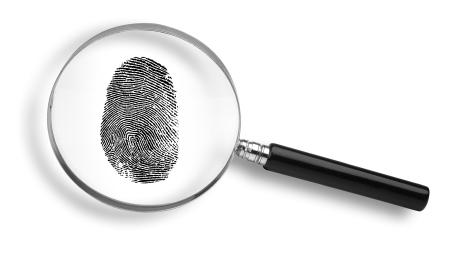| Complexity level: | 4 |
| Project cost ($): | 10 |
| Time required: | 4 hours for preparation, 1 hour to carry out the science fair project experiment |
| Material availability: | Easily obtained at a supermarket |
| Safety concerns: | None |
Hypothesis
The fingerprint obtained from a surface with a lower temperature will be clearer.
Overview
Fingerprints
The skin on the surface of our palm and feet has many ridges, called friction ridges. Every person will have a pattern of ridges that is unique only to them, and which will not change over time. The pattern of ridges on fingers is called the fingerprint.
These ridges help in amplifying the vibrations felt by our fingers, when rubbed over rough surfaces. They help us to feel and perceive the texture of a surface. Friction ridges also give us a better grip on smooth, wet, oily or slippery surfaces.
Fingerprints that are left on a surface are either patent or latent. Patent prints are left by substances like ink, blood, oil or paint, while latent prints are left on surfaces by skin secretions like oil or sweat. The latter is normally not visible to the naked eye. Forensic experts normally find and use the fingerprints found in a crime scene to identity the person or persons who had been present at the scene.
Scientific Terms
Materials
The materials required for this science fair project:
- 6 drinking glasses
- 1 bag of ice
- 1 hot plate
- 1 thermometer
- Tap water
- 1 bottle of cocoa powder
- 1 soft brush
- 1 roll of transparent cellophane tape (30mm width)
- A4 size paper
- 1 plastic glove
- 1 piece of cloth
- 1 black marker
Procedure
1. For this science fair project, the independent variable is the temperature of the drinking glasses. The dependent variable is the clarity of the fingerprint made on the glass. This is determined by comparing powdered copies of fingerprints obtained on pieces of cellophane tape. The constants (control variables) are the drinking glasses, the finger used to create the fingerprints, the cocoa power as well as the softness of the brush used.
2. Label the 6 drinking glasses as 0°C, 10°C, 20°C, 30°C, 40°C and 50°C respectively with the black marker. Record the temperatures on a sheet of A4 paper, 50mm apart.
3. Wear the plastic glove and carefully clean the drinking glasses with a wet cloth, removing all stains and fingerprints.
4. Fill the 6 glasses with tap water till they are about 80% full. Adjust the temperature of the water in each glass to 0°C, 10°C, 20°C, 30°C, 40°C or 50°C according to the temperature marked on each glass. Lower the temperature of the water by stirring in ice cubes, and increase the temperature of the water by placing the glass on a hot plate and setting it to the appropriate temperature.
5. Check the temperature of the water in each glass using a thermometer. Once the temperature of both the water and glass has stabilized, remove the plastic glove. Press a finger firmly against the surface of the glass to create a fingerprint.
6. Wear the plastic glove again and pour the water out from the glass. Allow the temperature of the glass to return to room temperature.
7. Sprinkle some cocoa powder on the surface of the glass. Using the soft brush gently dust the powder off the glass surface.A fingerprint will appear. Place the adhesive side of the transparent cellophane tape over the fingerprint to collect it. Then, stick the piece of tape onto the A4 paper, under the appropriate label.
8. Once all 6 prints have been taken and placed on the A4 paper, make a comparison and rate them 1 to 6. 1 being the clearest fingerprint and 6 being the least clear fingerprint.
Results
The results show that the fingerprint obtained at 0°C was the most clear. , The quality of the fingerprint obtained becomes more unclear as the temperature increases.
| Glass temperature | 0°C | 10°C | 20°C | 30°C | 40°C | 50°C |
| Fingerprint Rating | 1 | 2 | 3 | 4 | 5 | 6 |
Conclusion
The hypothesis that fingerprints obtained from a surface with lower temperature will be clearer has been proven to be true.
Fingerprints are now used for identification of individuals and at crime scene investigations. Some banks even use fingerprint detectors to verify the identity of a person before financial transactions are permitted. Access to certain restricted areas may also be controlled by fingerprint scanning. Sometimes, crossing country borders also requires fingerprint identification.
Also consider
The science fair project may be repeated by using different types of surfaces like marble, PVC or wood finishing.
References
Fingerprint - http://en.wikipedia.org/wiki/Fingerprint
Fingerprinting - http://www.cyberbee.com/whodunnit/dusting.html

